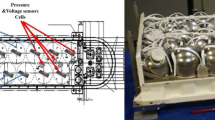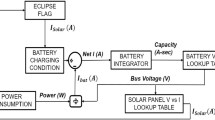Abstract
The electrical power subsystem (EPS) is one of the most critical subsystems in a spacecraft (SC). It provides the power needed for SC loads. Any failure in the EPS leads to SC mission failure. However, power budget calculation is necessary for the analysis of the energy flow of the SC subsystems for in-orbit nominal operation and to ensure the adequacy of solar array (SA) power and storage battery capacity. The average power generated by SA of a SC should be carefully calculated to accurately estimate the energy budget process. Nevertheless, SC operational scenarios should be designed and then justified by the power budget calculation. The investigation of power capability is to satisfy the mission requirements for all nominal operating modes of the SC. The solar illumination and orbit shadow period, as well as EPS parameters including SA output power, bus voltage, load profile, and storage battery capacity graph during in-orbit nominal operation, are all taken into consideration. In this paper, a mission profile with the worst-case scenario (WCS) for EPS of a Low-earth orbit (LEO) Cube-Sat is demonstrated. Moreover, a novel energy management strategy is developed using artificial intelligence to justify the power budget calculation of SC EPS.











Similar content being viewed by others
References
Lelekov A (2021) Estimation of the cubesat’s available energy for free-orientation scenario. IEEE Aerosp Electron Syst Mag 36(12):6–14. https://doi.org/10.1109/MAES.2021.3089233
Benini L, Castelli G, Macii A, Macii E, Poncino M, Scarsi R (2000) A discrete-time battery model for high-level power estimation. In: Proceedings design, automation and test in Europe conference and exhibition 2000 (Cat. No. PR00537), pp 35–39. https://doi.org/10.1109/DATE.2000.840012
Mokhtar MA, ElTohamy H, Elhalwagy Yehia Z, Mohamed EH (2023) Developing a novel battery management algorithm with energy budget calculation for low earth orbit (leo) spacecraft. Aerosp Syst. https://doi.org/10.1007/s42401-023-00260-3
Ali A, Khalily M, Sattarzadeh A, Massoud A, Hasna MO, Khattab T, Yurduseven O, Tafazolli R (2021) Power budgeting of leo satellites: an electrical power system design for 5g missions. IEEE Access. https://doi.org/10.1109/ACCESS.2021.3104098
Edpuganti A, Khadkikar V, Zeineldin H (2022) Single-input multiple-output converter for cubesat electric power system. In: 2022 IEEE 2nd international conference on sustainable energy and future electric transportation (SeFeT), pp 1–5. https://doi.org/10.1109/SeFeT55524.2022.9908948
Ali A, Massoud A, Hasna MO, Khattab T, Jabban T, Aref Nema M (2019) Modeling of cubesat orientation scenario and solar cells for internet of space provision. In: 2019 9th international conference on recent advances in space technologies (RAST), pp 541–546. https://doi.org/10.1109/RAST.2019.8767869
Chiu S-Y, Kim KA (2023) System analysis and design for multiconverter electrical power systems in nanosatellites. IEEE J Miniat Air Space Syst 4(1):41–53. https://doi.org/10.1109/JMASS.2022.3221277
Edpuganti A, Khadkikar V, Moursi MSE, Zeineldin H, Al-Sayari N, Al Hosani K (2022) A comprehensive review on cubesat electrical power system architectures. IEEE Trans Power Electron 37(3):3161–3177. https://doi.org/10.1109/TPEL.2021.3110002
Yaqoob M, Lashab A, Vasquez JC, Guerrero JM, Orchard ME, Bintoudi AD (2022) A comprehensive review on small satellite microgrids. IEEE Trans Power Electron 37(10):12741–12762. https://doi.org/10.1109/TPEL.2022.3175093
Mohamed AM, Amer FEH, Mostafa RM, Sarhan A (2022) Spacecraft nickel hydrogen storage battery experimental model. In: 2022 13th international conference on electrical engineering (ICEENG), pp 42–46. https://doi.org/10.1109/ICEENG49683.2022.9781878
Aissa B, Fethi L, Abdelhamid M (2018) Proposal criterion & method to estimate battery soc in spacecraft application. In: 2018 IEEE international conference on environment and electrical engineering and 2018 IEEE industrial and commercial power systems Europe (EEEIC/I &CPS Europe), pp 1–5. https://doi.org/10.1109/EEEIC.2018.8493491
Ali A, Khalily M, Sattarzadeh A, Massoud A, Hasna MO, Khattab T, Yurduseven O, Tafazolli R (2021) Power budgeting of leo satellites: an electrical power system design for 5g missions. IEEE Access. https://doi.org/10.1109/ACCESS.2021.3104098
Mohamed AM, Amer FEH, Mostafa RM, Wahballah WA (2018) Verification of solar array design for low earth orbit spacecraft under worst case scenario. In: 2018 IEEE aerospace conference, pp 1–11. https://doi.org/10.1109/AERO.2018.8396384
Sánchez-Sanjuán S, Gonzalez-Llorente J, Hurtado R (2016) Comparison of the incident solar energy and battery storage in a 3u cubesat satellite for different orientation scenarios. J Aerosp Technol Manag 8:91–102. https://doi.org/10.5028/jatm.v8i1.531
Acharya S, Alshehhi F, Tsoupos A, Khan O, Moursi Ms, Khadkikar V, Zeineldin H, Al Hosani M (2019) Modeling and design of electrical power subsystem for cubesats, pp 1–6. https://doi.org/10.1109/SEST.2019.8849042
Acharya S, Alshehhi F, Tsoupos A, Khan O, Moursi Ms, Khadkikar V, Zeineldin H, Al Hosani M (2019) Modeling and design of electrical power subsystem for cubesats, pp 1–6. https://doi.org/10.1109/SEST.2019.8849042
Mostacciuolo E, Iannelli L, Sagnelli S, Vasca F, Luisi R, Stanzione V (2018) Modeling and power management of a leo small satellite electrical power system. In: 2018 European control conference (ECC), pp 2738–2743. https://doi.org/10.23919/ECC.2018.8550095
Hussein B, Massoud AM, Khattab T (2022) Centralized, distributed, and module-integrated electric power system schemes in cubesats: performance assessment. IEEE Access 10:55396–55407. https://doi.org/10.1109/ACCESS.2022.3176902
Elkerdany MS, Safwat IM, Youssef AMM, Elkhatib MM (2022) A comparative analysis of energy management strategies for a fuel-cell hybrid electric system uav. In: 2022 IEEE aerospace conference (AERO), pp 1–10. https://doi.org/10.1109/AERO53065.2022.9843240
Elkerdany MS, Safwat IM, Mohamed Yossef AM, Elkhatib MM (2020) Hybrid fuel cell/battery intelligent energy management system for uav. In: 2020 16th international computer engineering conference (ICENCO), pp 88–91. https://doi.org/10.1109/ICENCO49778.2020.9357393
Funding
This study was funded by The Military Technical College (MTC).
Author information
Authors and Affiliations
Corresponding author
Ethics declarations
Conflict of interest
The authors have not disclosed any competing interests.
Rights and permissions
Springer Nature or its licensor (e.g. a society or other partner) holds exclusive rights to this article under a publishing agreement with the author(s) or other rightsholder(s); author self-archiving of the accepted manuscript version of this article is solely governed by the terms of such publishing agreement and applicable law.
About this article
Cite this article
Refaie, A.M.M., Elkerdany, M.S., Elhalwagy, Y.Z. et al. Design of a novel artificial intelligence technique for Cube-Sat power budget calculations. AS (2024). https://doi.org/10.1007/s42401-024-00278-1
Received:
Revised:
Accepted:
Published:
DOI: https://doi.org/10.1007/s42401-024-00278-1




